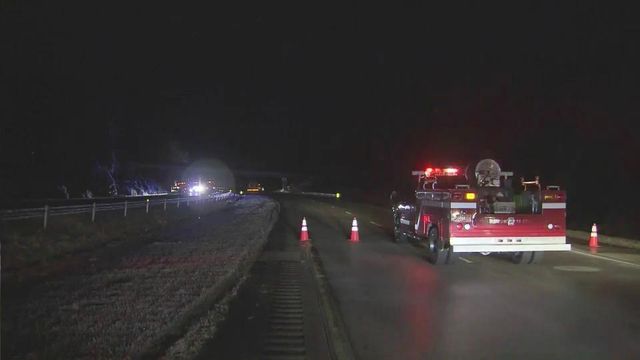Power outage numbers dropping in NC; less than 35,000 in Wake County
As of 6 p.m. Saturday, Duke Power was reporting on its website that 80,950 customers statewide were without power, including 34,203 in Wake County and 18,095 in Johnston County.
Posted — UpdatedFreezing precipitation slammed the Triangle and surrounding areas on Friday, causing treacherous roads and downed power lines across central North Carolina.
Fayetteville’s Public Works Commission reported 24 power outages as of 8 a.m. Saturday. PWC said three isolated outages have been reported since 6 a.m. Crews have responded to the remaining 21 and determined repairs are necessary before service can be restored.
Interstate 40 in Johnston County had issues for the majority of the day Friday, including downed power lines that shut down both sides of the road at mile marker 324 around 5:30 p.m.
Nearly two hours after the ice-coated lines fell to the road, authorities said a "suspected" drunk driver hit a Johnston County deputy, Matthew Johnson, who was assisting the repair of the electrical lines.
Officials said Johnson entered his vehicle just before the driver hit the passenger side. Johnson's K9 officer, Pinto, was also in the vehicle at the time of the accident.
Johnson was transported to a local hospital in Smithfield with non-life threatening injuries, and Pinto was unharmed in the wreck, officials said.
With sub-freezing temperatures lingering, and the continuation of freezing rain or sleet, moisture will continue to coat trees and power lines overnight and into the early hours on Saturday.
Safe practices during icy conditions
When heavy ice forms, take these precautions:
- Have a place in your home where flashlights, a battery-powered radio, and extra batteries can be easily found
- If you know the outage is coming, set aside extra water and buy or make extra ice. You can use the ice to keep perishable items cool
- Make sure the battery in your smoke detector is fresh
- If possible, use flashlights instead of candles for emergency lighting. Candles used in unfamiliar settings can be dangerous fire hazards
- Leave one light on so you know when the power returns
- Avoid opening the refrigerator and freezer. This will help keep your food as fresh as possible. Be sure to check food for signs of spoilage
- Use generators safely. If you have a portable generator, only run it outdoors with adequate ventilation
- Never use a generator indoors or in attached garages. The exhaust fumes contain carbon monoxide, which can be deadly if inhaled
- Listen to the radio for updates
- Your homeowner policy may cover spoiled food and other damages as a result of power outages, subject to the deductible. Check with your insurance company to see if your homeowner policy covers damages resulting from outages
- When the power goes out – many turn to candles for light:
- On average, 42 home candle fires are reported every day
- On average, 42 home candle fires are reported every day
- Home heating equipment is second to cooking fires for causing home structure fires
- Avoid setting up a space heater too close to curtains, furniture, or decorations. Remember to keep at least three feet of clear space around it and set it up on the floor unless it is designed for other use
- Burn Wood in the Fireplace: Do not burn trash, cardboard boxes or debris in the fireplace
- These items burn unevenly and may cause a dangerous flash fire
- Damage can exceed $15,000, and the average runs $8,000
- Both plastic PVC and metal pipes freeze
- A trickle of water can make the difference
- Coverage typically applies when tree or limbs hits insured structure or vehicle
- If tree strikes nothing when it falls, there typically is not coverage for tree removal
- Ninety-six percent had at least one emergency supply in their vehicle, such as a spare tire or jumper cables, but only five percent carried all the essential emergency roadside supplies: hazard triangle/road flares, flashlight, first aid kit, water, blanket, etc.
- When clearing snow from vehicle, don’t forget the tailpipe. It can cause carbon monoxide poisoning when clogged
• Credits
Copyright 2024 by Capitol Broadcasting Company. All rights reserved. This material may not be published, broadcast, rewritten or redistributed.






